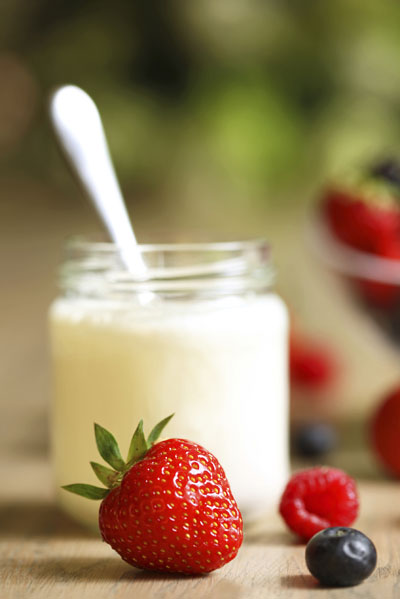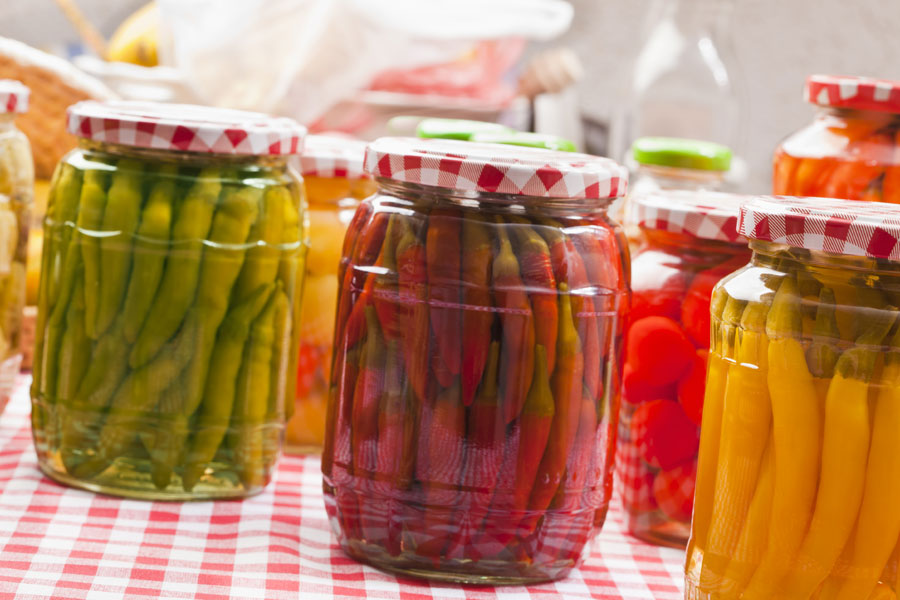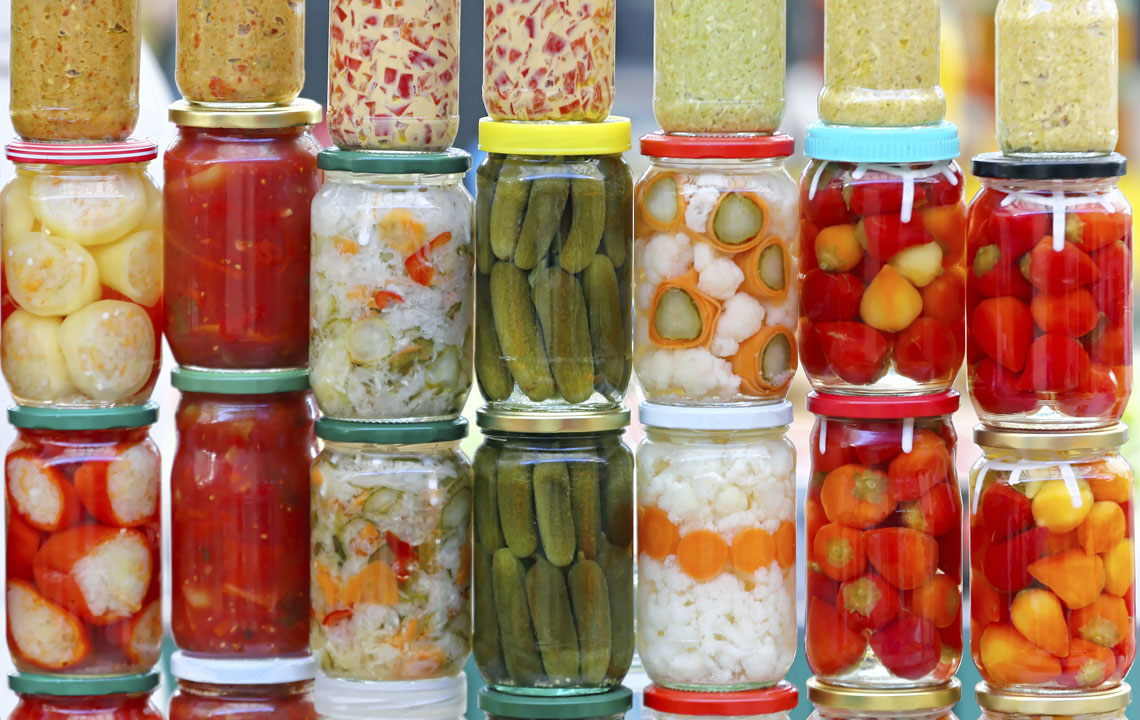Canning has made a crazy comeback.
Bon Appetit, Martha Stewart, Natural Home…it seems every food and health magazine has covered canning tutorials at length. My mother even talked me into buying a canner to can some of our amazing local tomatoes. But she ended up canning them…not me.
I’m just not that into canning. There. Admitted it.
I’m a natural foods chef, health writer, local foods enthusiast, frequent farmers’ market shopper and vocal food activist…yet I don’t care to learn about, mess around with, or attempt canning.
Why? Oh-so-many reasons.
It’s labor/time intensive; finicky; I can buy perfectly good organic, canned tomatoes in glass jars from my co-op; there’s a good chance the lids won’t seal even after all my hard work and investment; and it’s just too darn hot and sweaty in the long Georgia summer.
However, I do preserve a variety of vegetables and dairy on a weekly basis and make my own probiotics with very little effort (and no sweating).
How do I do this? It’s a no-brainer method called lacto-fermentation, and I’m going to teach you how easy it is to do at home.
What is lacto-fermentation?
 Lacto-fermentation is the art of preserving foods (vegetables, fruits, dairy) by adding a salty brine, whey, starter, or just letting something naturally “sour”.
Lacto-fermentation is the art of preserving foods (vegetables, fruits, dairy) by adding a salty brine, whey, starter, or just letting something naturally “sour”.
Think pickles, sauerkraut, yogurt, kefir, miso and kombucha.
The “lacto” term comes from the good bacteria (lactobacillus) that come from letting the food sit and ferment.
Our ancestors (dating back to ancient times) ate loads of fermented foods out of necessity, and they didn’t struggle with the modern digestive and immune illnesses adults and children do today.
Recent research on the microbiome (the over 1 trillion germs that live in our digestive tract, mouth, skin, and other body parts) reveals a diet rich in cultured foods, among other things, helps build a diversified microbiome and gut ecology that protects us from disease.
There are many books about The GAPS (Gut and Psychology Syndrome) Diet, which tout the benefits of probiotic-rich lactofermented foods, including its benefit for children facing modern illness, including ADD/ADHD, autism, asthma and other neurological and digestive-related disorders.
Why lacto-fermentation over canning?
If you love or are drawn to canning, by all means keep it up (and feel free to come can at my house).
Home preservation of any type is a wonderful and health-giving skill, especially since most store-bought canned products are housed in cans with a potentially cancer-causing BPA-lining.
However, for those who loathe the idea of canning or are squeezed for time, there are some big benefits to lacto-fermentation.
-
It’s easy—Most lactofermented foods require very little effort and nearly zero skill. For example, if you can purchase a starter online, add it to some whole milk, shove it in a warm place and leave it a few hours, you’ve got yogurt. So simple.
-
It makes allergenic foods (like dairy) more digestible—Fermented foods provide a wealth of live enzymes, making them easy to digest. Even those with dairy sensitivities or allergies can usually handle fermented milk products.
-
It’s cheap—The irony is most pre-made lactofermented foods (like kombucha or real pickles) come at gourmet-level prices. Yet to make them at home only costs pennies on the dollar and a small slice of time.
-
It’s a fun activity to do with the kids—If you homeschool or just enjoy exploring science and life skills with your children through cooking, lacto-fermentation is a fun and safe way to experiment in the kitchen and connect with your food.
-
It yields superior strains of health-giving probiotics and prebiotics—Probiotics are essential for building a healthy gut, but they can get expensive. By incorporating a few lactofermented foods into your life you’ll be getting a wide variety of probiotics delivered straight from your own kitchen.
-
No fancy equipment required—You only need some glass jars, a wooden spoon, and a warm place to store. That’s it. (A food processor or blender is helpful but not essential.)
-
It enhances the nutritional profile of food—The naturally-occurring probiotics and enzymes help the body better digest and absorb nutrients, such as B-Vitamins, found in fermented foods.
-
Lactofermented foods especially benefit children with neurological/gut-related disorders—I thought this was worth repeating. For more info from a medical pioneer in the field, check out The GAPS diet website.

What foods can be lactofermented?
Nearly any vegetable, dairy product, grain or fruit (think chutneys) can be lactofermented. There are even recipes for lactofermented ketchup out there.
I don’t ferment meat or fish because I don’t have the desire to eat fermented meat and it’s much more labor-intensive (due to the risk of contamination) than produce or dairy.
Lactofermented foods are some of the safest and healthiest to eat
Many people shy away from fermenting foods at home because they fear contamination or foodborne illness. I mean, you are essentially “souring” foods…couldn’t that make you sick?
Though modern logic would suggest this is the case, the opposite is true.
It is through the souring that comes activation of the natural lactobacillus cultures, which create an acidic environment (kind of like vinegar) that is inhospitable to harmful bacteria.
Lactofermented foods therefore contain their own built-in immunity, if you will.
Can fermented foods go bad?
Sure. Especially if the environment they were prepared in was unclean, or the temperature they were left to ferment in was too cool or too hot or if you forget about them for too long (like I have before). Mold can be an issue in humid climates.
The best way to tell if a fermented food goes “off” is by smelling it. If it smells putrid, you see mold, or you suspect it’s contaminated, toss it and start over. If it smells sour but pleasant, you’re good-to-go.
Also, as cultures age—like a yogurt or kefir for example—they often begin to produce an effervescent “fizzy” effect on milk. This is something to celebrate -- not fear. It means your culture is wonderfully active and ALIVE with probiotics.
How to get started
An easy place to start is by making your own yogurt. Kids love it. You can blend it into smoothies or even use it to make popsicles or homemade frozen yogurt.
And making your own is way cheaper than buying organic or pasture-raised yogurt (which can cost over $7 a pint).
Recipe: DIY Yogurt
-
First, purchase a starter. I like the ones from culturesforhealth or Yogourmet, which can be found in many local or online natural foods stores.
-
Buy some raw or organic pasture-raised whole milk (you can buy 2% or skim but your body will greatly benefit from the CLA and omega-3 fats present in whole milk from pasture-raised cows).
-
Heat the milk to scalding (just before boiling), stirring often.
-
Cool in an ice bath in the sink.
-
Once cooled, stir in the yogurt starter with a whisk until completely dissolved.
-
Pour the inoculated milk into glass jars and place either in a yogurt maker (I use this one) or a warm place (like in your microwave over the stove with the exhaust fan light turned on, or in an oven with a pilot light on).
-
Leave for 6-12 hours, or until it looks and jiggles like yogurt should.
-
Refrigerate, and you’re done.
If you don’t care for plain yogurt just add some all-fruit jam to taste. You’ll get way less sugar (and no artificial sweeteners or colors) than with store-bought flavors and you can customize every bowl.
Be sure to save about half a cup as your “starter” for your next batch (I hide mine in the vegetable crisper). From there, you’ll save half a cup every time you make it and, unless you fudge a batch, that’s your lifelong starter.
Some families have yogurt starters dating back generations.
Please note: Your first batch will always take longer to “yog.” If you have to leave it longer than 12 hours that’s okay—I’ve left mine up to 24 hours before. Subsequent batches will set up much faster.
If you’re using goat’s milk, that also will take longer to “yog” (usually 12-24 hours), and even when it's ready it will be a runnier texture. The best way I’ve found to make thicker goat yogurt is to add some powdered goat milk to the heated mixture.
Lactofermented Dilly Carrots Sticks (follow the link)
A friend of mine turned me onto this recipe from The Nourishing Gourmet.
If your children love pickles (like my little one) these are sure to be a healthy hit.
Note: This recipe suggests using whey. The easiest way to get whey is to strain some yogurt in a cheese cloth over a sieve for a few hours in the fridge. The cloudy liquid that comes out is whey…easy! Plus, you’re left with a thick, luxuriously creamy Greek-style yogurt to enjoy.
Where to learn more
Books:
“Nourishing Traditions” by Sally Fallon and Mary Enig—this book is a nutrition education in itself, with a HUGE range of traditional recipes including fermented dairy, grains, breads, vegetables, meats, fruits and chutneys, and tons of yummy beverages like traditional ginger beer.
“The Art of Fermentation” by Sandor Katz—is an excellent go-to resource of fermented recipes. Easy to follow, educational, inspirational, creative, and reliable…this is a must-have for every modern kitchen.
Online:
Culturesforhealth—offers a ton of free recipes, tools, cultures, books, and advice on all things lacto-fermentation.
Thehappyherbalist Kombucha Starter Kit— comes with everything you need to make yummy, trendy kombucha at home (including a how-to guide). I’ve used their starter kit with great success and highly recommend their products. Please note, kombucha does have a bit of alcohol and may not be suitable for children or pregnant women (do your own research as there are different schools of thought on this).
The Body Ecology Diet website—is a wonderful resource of recipes, health information, and how-to guides on a variety of lacto-fermented foods including cultured vegetables (aka sauerkraut).
Whether you’re gung-ho canning or not, lacto-fermentation is a simple and priceless skill that could provide an integral piece of the puzzle to modern health issues.
Have I inspired you to try lactofermenting at home? What’s your experience with home-fermentation? Have you or your children reaped the health benefits of fermented foods?
We’d love to hear your stories in the comments section below.
In health,
-Kristen
Are you looking for rural land to set up your dream homesite? View land for sale throughout the South in Florida, Georgia and Texas on our parent company's website at RaydientPlaces.com.

























